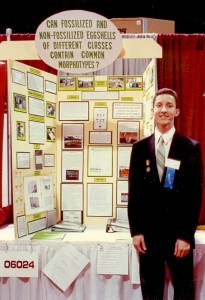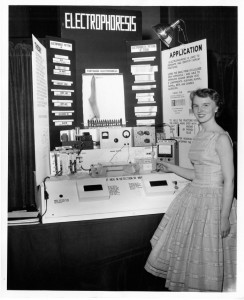My son’s avowed interest in all-things-dinosaurs from the age of ten, combined with the boundless sense of wonder that all kids have, made it possible for him to use his four high school science fair projects to interpret the microstructures of dinosaur eggshells in some ways other scientists had not previously thought of. As a result, he delivered a presentation to more than a thousand scientists at the annual Society of Vertebrate Paleontology Conference — at the age of 20.
Informal science education, such as the type of learning a student gets outside of the normal classroom environment by participating in a science fair, provides kids with an in-depth and hands-on look at “real world” science. While it’s possible that participation in a science fair can open doors for students who have already discovered their abilities and passion for science, it can also help students develop an interest in science which could be important to them no matter what career they choose.
Getting students interested in hands-on science now is actually very important for another reason, since a new national set of science education standards is under development. The Next Generation Science Standards have a targeted release date of 2013.
Some of the most important arguments for the Next Generation Science Standards are: 1) American students are falling behind in math and science, performing at levels below students in competitor nations on international tests; the United States currently ranks 25th in math and 17th in science among developed nations, 2) fewer students are pursuing careers in Science, Technology, Engineering and Math (STEM) disciplines, and 3) science is profoundly important to address the problems we’re now facing such as preventing and curing diseases, maintaining supplies of clean water and addressing the energy crisis.
Our collective futures are dependent upon students being interested in science. The purpose of more science education, broadly expressed as ‘STEM literacy’ is to motivate all students (not just the parents and students who are already a fan of science) to fully engage in the very active practices of science and engineering. Aside from the movement to provide 100,000 STEM teachers over the next decade, the other important reason to help your child become interested in science is that through the Next Generation Science Standards, students will be tested on STEM literacy in school.
As your child passes through all grade levels, the new Next Generation Science Standards testing will be evaluating your child’s skills and capabilities in areas such as:
1. Asking questions (for science) and defining problems (for engineering)
2. Developing and using models
3. Planning and carrying out investigations
4. Analyzing and interpreting data
5. Using mathematics and computational thinking
6. Constructing explanations (for science) and designing solutions (for engineering)
7. Engaging in argument from evidence
8. Obtaining, evaluating, and communicating information
In essence, the new standards recognize that “science, engineering and technology permeate every aspect of modern life” and that by the time a student graduates high school they “should have sufficient knowledge of science and engineering to engage in public discussions on science-related issues, to be critical consumers of scientific information related to their everyday lives, and to be able to continue to learn about science throughout their lives.” (See the Report Brief from the Framework for K-12 Science Education for more details.).
Being a scientist or having an interest in science is no longer relegated to a bunch of old men in white coats with goggles, pens in pocket protectors, grumpy attitudes and an inability to talk about anything other than research.
A scientist can be someone who is 20 or 30 years old and who digs dinosaur eggs in the Montana badlands, does all his communication through a PDA, excitedly jumps up and down upon finding a 20-million-year-old fossil of a previously undiscovered life-form, and enjoys talking about music and videos and computer games and lots of other things with his friends.
A non-scientist – but someone who has an interest in, and an understanding of science – might be the salesperson at the appliance store who can help you select the most cost-effective furnace, or the grocery store clerk who understands the potential for botulism if meat isn’t properly refrigerated, or the politician who’s fighting for a clean-energy policy.
Science is all around us, and it benefits everyone at every age, to become more science literate.

As a college junior, Barnas Monteith was given the distinct honor of being the youngest person to give a Plenary session lecture before the Society for Vertebrate Paleontology, which is the central professional organization for dinosaur paleontologists from around the world. Barnas’ interest in dinosaurs since he was six years old, led to his cross-disciplinary study of eggshells for his four years of high-school science fair projects.



